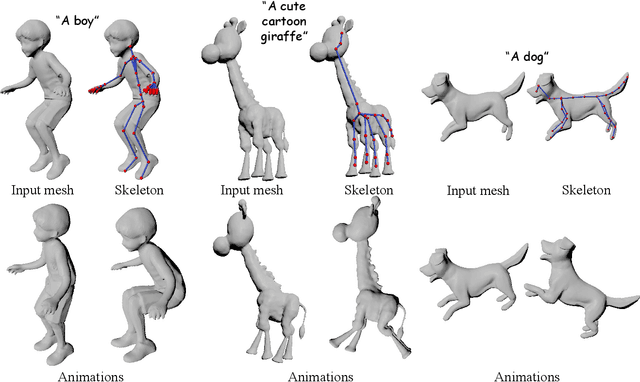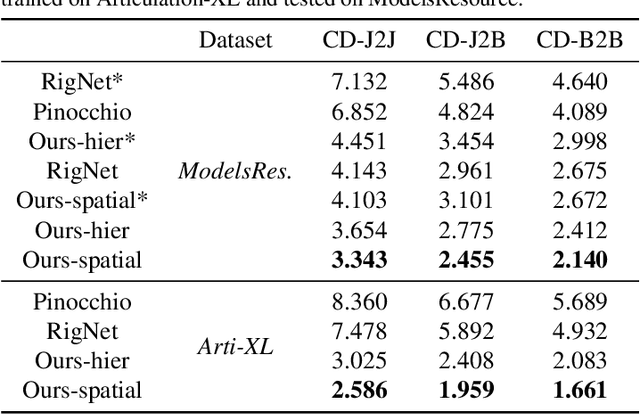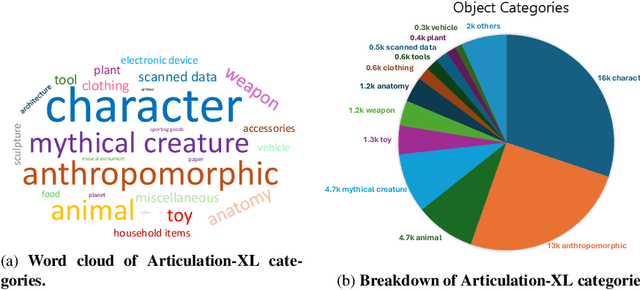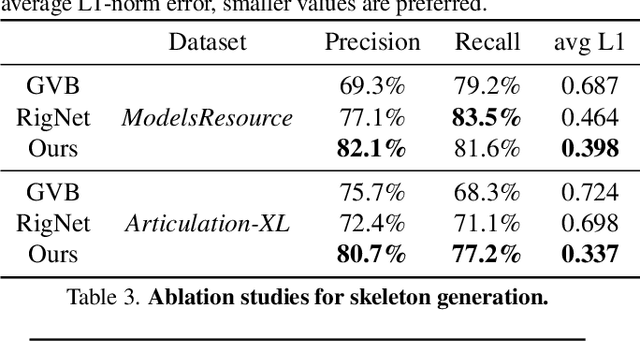Yiwen Chen
Ultra3D: Efficient and High-Fidelity 3D Generation with Part Attention
Jul 23, 2025Abstract:Recent advances in sparse voxel representations have significantly improved the quality of 3D content generation, enabling high-resolution modeling with fine-grained geometry. However, existing frameworks suffer from severe computational inefficiencies due to the quadratic complexity of attention mechanisms in their two-stage diffusion pipelines. In this work, we propose Ultra3D, an efficient 3D generation framework that significantly accelerates sparse voxel modeling without compromising quality. Our method leverages the compact VecSet representation to efficiently generate a coarse object layout in the first stage, reducing token count and accelerating voxel coordinate prediction. To refine per-voxel latent features in the second stage, we introduce Part Attention, a geometry-aware localized attention mechanism that restricts attention computation within semantically consistent part regions. This design preserves structural continuity while avoiding unnecessary global attention, achieving up to 6.7x speed-up in latent generation. To support this mechanism, we construct a scalable part annotation pipeline that converts raw meshes into part-labeled sparse voxels. Extensive experiments demonstrate that Ultra3D supports high-resolution 3D generation at 1024 resolution and achieves state-of-the-art performance in both visual fidelity and user preference.
CDC: Causal Domain Clustering for Multi-Domain Recommendation
Jul 09, 2025Abstract:Multi-domain recommendation leverages domain-general knowledge to improve recommendations across several domains. However, as platforms expand to dozens or hundreds of scenarios, training all domains in a unified model leads to performance degradation due to significant inter-domain differences. Existing domain grouping methods, based on business logic or data similarities, often fail to capture the true transfer relationships required for optimal grouping. To effectively cluster domains, we propose Causal Domain Clustering (CDC). CDC models domain transfer patterns within a large number of domains using two distinct effects: the Isolated Domain Affinity Matrix for modeling non-interactive domain transfers, and the Hybrid Domain Affinity Matrix for considering dynamic domain synergy or interference under joint training. To integrate these two transfer effects, we introduce causal discovery to calculate a cohesion-based coefficient that adaptively balances their contributions. A Co-Optimized Dynamic Clustering algorithm iteratively optimizes target domain clustering and source domain selection for training. CDC significantly enhances performance across over 50 domains on public datasets and in industrial settings, achieving a 4.9% increase in online eCPM. Code is available at https://github.com/Chrissie-Law/Causal-Domain-Clustering-for-Multi-Domain-Recommendation
DeepMesh: Auto-Regressive Artist-mesh Creation with Reinforcement Learning
Mar 19, 2025



Abstract:Triangle meshes play a crucial role in 3D applications for efficient manipulation and rendering. While auto-regressive methods generate structured meshes by predicting discrete vertex tokens, they are often constrained by limited face counts and mesh incompleteness. To address these challenges, we propose DeepMesh, a framework that optimizes mesh generation through two key innovations: (1) an efficient pre-training strategy incorporating a novel tokenization algorithm, along with improvements in data curation and processing, and (2) the introduction of Reinforcement Learning (RL) into 3D mesh generation to achieve human preference alignment via Direct Preference Optimization (DPO). We design a scoring standard that combines human evaluation with 3D metrics to collect preference pairs for DPO, ensuring both visual appeal and geometric accuracy. Conditioned on point clouds and images, DeepMesh generates meshes with intricate details and precise topology, outperforming state-of-the-art methods in both precision and quality. Project page: https://zhaorw02.github.io/DeepMesh/
MagicArticulate: Make Your 3D Models Articulation-Ready
Feb 18, 2025



Abstract:With the explosive growth of 3D content creation, there is an increasing demand for automatically converting static 3D models into articulation-ready versions that support realistic animation. Traditional approaches rely heavily on manual annotation, which is both time-consuming and labor-intensive. Moreover, the lack of large-scale benchmarks has hindered the development of learning-based solutions. In this work, we present MagicArticulate, an effective framework that automatically transforms static 3D models into articulation-ready assets. Our key contributions are threefold. First, we introduce Articulation-XL, a large-scale benchmark containing over 33k 3D models with high-quality articulation annotations, carefully curated from Objaverse-XL. Second, we propose a novel skeleton generation method that formulates the task as a sequence modeling problem, leveraging an auto-regressive transformer to naturally handle varying numbers of bones or joints within skeletons and their inherent dependencies across different 3D models. Third, we predict skinning weights using a functional diffusion process that incorporates volumetric geodesic distance priors between vertices and joints. Extensive experiments demonstrate that MagicArticulate significantly outperforms existing methods across diverse object categories, achieving high-quality articulation that enables realistic animation. Project page: https://chaoyuesong.github.io/MagicArticulate.
One for Dozens: Adaptive REcommendation for All Domains with Counterfactual Augmentation
Dec 16, 2024



Abstract:Multi-domain recommendation (MDR) aims to enhance recommendation performance across various domains. However, real-world recommender systems in online platforms often need to handle dozens or even hundreds of domains, far exceeding the capabilities of traditional MDR algorithms, which typically focus on fewer than five domains. Key challenges include a substantial increase in parameter count, high maintenance costs, and intricate knowledge transfer patterns across domains. Furthermore, minor domains often suffer from data sparsity, leading to inadequate training in classical methods. To address these issues, we propose Adaptive REcommendation for All Domains with counterfactual augmentation (AREAD). AREAD employs a hierarchical structure with a limited number of expert networks at several layers, to effectively capture domain knowledge at different granularities. To adaptively capture the knowledge transfer pattern across domains, we generate and iteratively prune a hierarchical expert network selection mask for each domain during training. Additionally, counterfactual assumptions are used to augment data in minor domains, supporting their iterative mask pruning. Our experiments on two public datasets, each encompassing over twenty domains, demonstrate AREAD's effectiveness, especially in data-sparse domains. Source code is available at https://github.com/Chrissie-Law/AREAD-Multi-Domain-Recommendation.
OmnixR: Evaluating Omni-modality Language Models on Reasoning across Modalities
Oct 16, 2024Abstract:We introduce OmnixR, an evaluation suite designed to benchmark SoTA Omni-modality Language Models, such as GPT-4o and Gemini. Evaluating OLMs, which integrate multiple modalities such as text, vision, and audio, presents unique challenges. Particularly, the user message might often consist of multiple modalities, such that OLMs have to establish holistic understanding and reasoning across modalities to accomplish the task. Existing benchmarks are limited to single modality or dual-modality tasks, overlooking comprehensive multi-modal assessments of model reasoning. To address this, OmnixR offers two evaluation variants: (1)synthetic subset: a synthetic dataset generated automatically by translating text into multiple modalities--audio, images, video, and hybrids (Omnify). (2)realistic subset: a real-world dataset, manually curated and annotated by experts, for evaluating cross-modal reasoning in natural settings. OmnixR presents a unique evaluation towards assessing OLMs over a diverse mix of modalities, such as a question that involves video, audio, and text, providing a rigorous cross-modal reasoning testbed unlike any existing benchmarks. Our experiments find that all state-of-the-art OLMs struggle with OmnixR questions that require integrating information from multiple modalities to answer. Further analysis highlights differences in reasoning behavior, underscoring the challenges of omni-modal AI alignment.
MeshAnything V2: Artist-Created Mesh Generation With Adjacent Mesh Tokenization
Aug 05, 2024

Abstract:We introduce MeshAnything V2, an autoregressive transformer that generates Artist-Created Meshes (AM) aligned to given shapes. It can be integrated with various 3D asset production pipelines to achieve high-quality, highly controllable AM generation. MeshAnything V2 surpasses previous methods in both efficiency and performance using models of the same size. These improvements are due to our newly proposed mesh tokenization method: Adjacent Mesh Tokenization (AMT). Different from previous methods that represent each face with three vertices, AMT uses a single vertex whenever possible. Compared to previous methods, AMT requires about half the token sequence length to represent the same mesh in average. Furthermore, the token sequences from AMT are more compact and well-structured, fundamentally benefiting AM generation. Our extensive experiments show that AMT significantly improves the efficiency and performance of AM generation. Project Page: https://buaacyw.github.io/meshanything-v2/
Snail-Radar: A large-scale diverse dataset for the evaluation of 4D-radar-based SLAM systems
Jul 16, 2024



Abstract:4D radars are increasingly favored for odometry and mapping of autonomous systems due to their robustness in harsh weather and dynamic environments. Existing datasets, however, often cover limited areas and are typically captured using a single platform. To address this gap, we present a diverse large-scale dataset specifically designed for 4D radar-based localization and mapping. This dataset was gathered using three different platforms: a handheld device, an e-bike, and an SUV, under a variety of environmental conditions, including clear days, nighttime, and heavy rain. The data collection occurred from September 2023 to February 2024, encompassing diverse settings such as roads in a vegetated campus and tunnels on highways. Each route was traversed multiple times to facilitate place recognition evaluations. The sensor suite included a 3D lidar, 4D radars, stereo cameras, consumer-grade IMUs, and a GNSS/INS system. Sensor data packets were synchronized to GNSS time using a two-step process: a convex hull algorithm was applied to smooth host time jitter, and then odometry and correlation algorithms were used to correct constant time offsets. Extrinsic calibration between sensors was achieved through manual measurements and subsequent nonlinear optimization. The reference motion for the platforms was generated by registering lidar scans to a terrestrial laser scanner (TLS) point cloud map using a lidar inertial odometry (LIO) method in localization mode. Additionally, a data reversion technique was introduced to enable backward LIO processing. We believe this dataset will boost research in radar-based point cloud registration, odometry, mapping, and place recognition.
HouseCrafter: Lifting Floorplans to 3D Scenes with 2D Diffusion Model
Jun 28, 2024



Abstract:We introduce HouseCrafter, a novel approach that can lift a floorplan into a complete large 3D indoor scene (e.g., a house). Our key insight is to adapt a 2D diffusion model, which is trained on web-scale images, to generate consistent multi-view color (RGB) and depth (D) images across different locations of the scene. Specifically, the RGB-D images are generated autoregressively in a batch-wise manner along sampled locations based on the floorplan, where previously generated images are used as condition to the diffusion model to produce images at nearby locations. The global floorplan and attention design in the diffusion model ensures the consistency of the generated images, from which a 3D scene can be reconstructed. Through extensive evaluation on the 3D-Front dataset, we demonstrate that HouseCraft can generate high-quality house-scale 3D scenes. Ablation studies also validate the effectiveness of different design choices. We will release our code and model weights. Project page: https://neu-vi.github.io/houseCrafter/
MeshAnything: Artist-Created Mesh Generation with Autoregressive Transformers
Jun 14, 2024



Abstract:Recently, 3D assets created via reconstruction and generation have matched the quality of manually crafted assets, highlighting their potential for replacement. However, this potential is largely unrealized because these assets always need to be converted to meshes for 3D industry applications, and the meshes produced by current mesh extraction methods are significantly inferior to Artist-Created Meshes (AMs), i.e., meshes created by human artists. Specifically, current mesh extraction methods rely on dense faces and ignore geometric features, leading to inefficiencies, complicated post-processing, and lower representation quality. To address these issues, we introduce MeshAnything, a model that treats mesh extraction as a generation problem, producing AMs aligned with specified shapes. By converting 3D assets in any 3D representation into AMs, MeshAnything can be integrated with various 3D asset production methods, thereby enhancing their application across the 3D industry. The architecture of MeshAnything comprises a VQ-VAE and a shape-conditioned decoder-only transformer. We first learn a mesh vocabulary using the VQ-VAE, then train the shape-conditioned decoder-only transformer on this vocabulary for shape-conditioned autoregressive mesh generation. Our extensive experiments show that our method generates AMs with hundreds of times fewer faces, significantly improving storage, rendering, and simulation efficiencies, while achieving precision comparable to previous methods.
 Add to Chrome
Add to Chrome Add to Firefox
Add to Firefox Add to Edge
Add to Edge